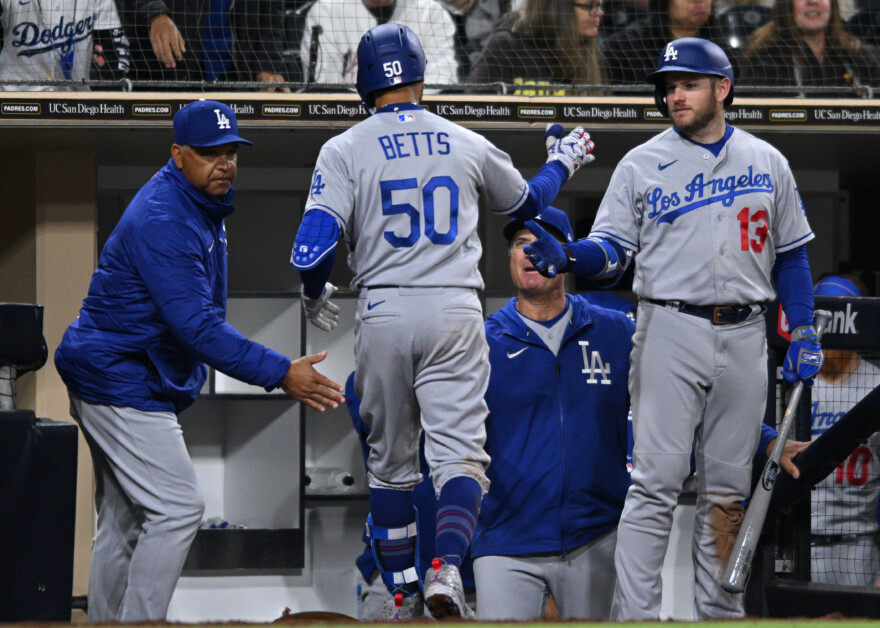Jack Flaherty has been a key piece to the Los Angeles Dodgers rotation since they acquired him from the Detroit Tigers at the trade deadline, and they’re counting on him to be a major part of their postseason.
However, there is one trend that has caused some concern with the right-hander. Flaherty’s average fastball velocity has been in a steep decline, dropping from an average of 93.8 mph at it’s peak this year to 92.6 mph in September.
From a game-by-game basis, Flaherty topped out at an average of 95.1 mph earlier this season, and in his final two starts of the year, turned in his lowest averages at just 91.8 and 91.9 mph, respectively.
While a decline in fastball velocity is often an indicator of injury or fatigue, Dodgers president of baseball operations Andrew Friedman ruled out both of those, instead explaining it’s a mechanical issue.
“A little bit of delivery stuff that I know Connor (McGuiness), Mark (Prior) and B-Mac (Brandon McDaniel) have been attacking,” Friedman said of the velocity decline. “Jack’s great. He gets it and gets after it. He feels really confident that his delivery is in a really good place.”
This isn’t the first time Flaherty’s velocity has fluctuated greatly at some point in 2024. In a series of starts from May 18 to June 15, Flaherty saw his average velocity drop in each outing, going from 94.3 mph to 92.2 mph.
After that final start where his velocity was near its floor, it trended back up over his next few outings, reaching an average of 94 mph by July 19.
Fastball velocity inconsistency has been notable for Flaherty. From April to September, he’s posted average monthly velocities of 93.8, 93.8, 92.8, 93.4, 93.5 and 92.6 mph.
While roughly 1 mph may not seem like a major difference, that can turn out to be significant for a pitcher, especially when noting it’s an average so there are going to be many pitches a few ticks below that mark.
When facing fastballs that sit 89-90 mph, players hit .290/.369/.539 this season. When the average velocity increased to 91-92 mph, hitters’ production declined to a .267/.344/.487 batting line.
Against fastballs in the 93-94 mph range, hitters batted .250/.344/.438/.782. At 95-96 mph, hitters were batting .241/.328/.411/.739.
The trend continues with larger declines for each two-mph increment up to 102 mph while whiff rate also increases in each tier of velocity.
Flaherty can still be effective even without his peak velocity, which he’s already proven to be. But if he can get back on track and throwing harder, that takes his upside from that of a solid No. 2 starter to true ace-level for the Dodgers.
And while his mechanics seem to be the primary reason for the decline, the adrenaline of the playoff atmosphere should also provide a boost. Pitchers typically see their velocity trend up during October.
Dodgers change Jack Flaherty’s NLDS start
After the Dodgers previously announced Flaherty start Game 1 of the National League Division Series, they instead changed their plans, turning to Yoshinobu Yamamoto to take the opener against the San Diego Padres.
Friedman explained the decision was to better align with Yamamoto’s rest schedule and give them more options for a potential Game 5 and the playoffs moving forward.
“Much more about if there’s a potential for a Game 5, Yoshi hasn’t pitched on regular and Jack is much more accustomed to it,” Friedman said. “And depending on ‘pen usage throughout, it allows us to add flexibility in Game 5, if there is one. So it’s just about having more options.”
Have you subscribed to the Dodger Blue YouTube channel? Be sure to ring the notification bell to watch player interviews, participate in shows and giveaways, and stay up to date on all Dodgers news and rumors!







